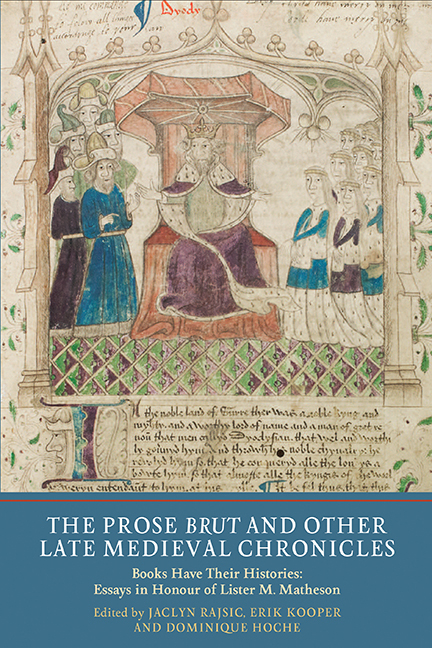 The Prose Brut and Other Late Medieval Chronicles
The Prose Brut and Other Late Medieval Chronicles Book contents
- Frontmatter
- Dedication
- Contents
- List of Plates
- List of Contributors
- Acknowledgements
- Curriculum Vitae of Lister M. Matheson
- Introduction
- A Memoir: The Whole Haggis: Lessons From the Work of Lister M. Matheson
- Part I Uses of History
- Part II The Prose Brut
- Part III Receptions and Afterlives of Late Medieval Chronicles
- 9 Trevet's Les Cronicles: Manuscripts, Owners and Readers
- 10 Matthew Parker and the Middle English Prose Brut
- 11 Thomas Hearne and English Chronicles
- 12 The Manuscript of Castleford's Chronicle: Its History and its Scribes
- 13 Bruts for Sale
- Index of Manuscripts Cited
- General Index
- Tabula in Memoriam
12 - The Manuscript of Castleford's Chronicle: Its History and its Scribes
from Part III - Receptions and Afterlives of Late Medieval Chronicles
Published online by Cambridge University Press: 05 July 2016
- Frontmatter
- Dedication
- Contents
- List of Plates
- List of Contributors
- Acknowledgements
- Curriculum Vitae of Lister M. Matheson
- Introduction
- A Memoir: The Whole Haggis: Lessons From the Work of Lister M. Matheson
- Part I Uses of History
- Part II The Prose Brut
- Part III Receptions and Afterlives of Late Medieval Chronicles
- 9 Trevet's Les Cronicles: Manuscripts, Owners and Readers
- 10 Matthew Parker and the Middle English Prose Brut
- 11 Thomas Hearne and English Chronicles
- 12 The Manuscript of Castleford's Chronicle: Its History and its Scribes
- 13 Bruts for Sale
- Index of Manuscripts Cited
- General Index
- Tabula in Memoriam
Summary
Go, litel bok, go, litel myn [historie]
Chaucer, modifiedTHE Brut chronicle family has many branches, as Lister Matheson and others have increasingly brought to light. Although Castleford's Chronicle, the immensely long verse chronicle to be discussed here, is surely one of the lesser relations and had, to my knowledge, no direct progeny, nevertheless it is a valuable witness to the development of the Brut tradition in a northern English context. This chronicle is known to exist in only one manuscript, which, as I will show, can be traced from a Yorkshire origin, as the fifteenth-century product of an imperfect collaboration between two main scribes and a rubricator; to a probable sojourn in Westminster or London in conjunction with its ownership by an avid book collector who was, by one dubious account, perhaps also a murderer; to an eighteenth-century transition to the Continent among the household goods of a Londoner serving as a minor official in Germany, where it acquired its present designation as Göttingen, Niedersächsische Staats- und Universitätsbibliothek, MS 2o Cod. hist. 740 Cim. This itinerary shows the continuing circulation of a somewhat aberrant version of the underlying Brut narrative across regional and national distances and across time.
Recent studies of England's medieval book culture have emphasized the importance of diversified and interrelated networks of writers, readers and owners of books, not only in London as the main metropolitan center but also in other cities and in local and regional contexts, including Yorkshire and other parts of the North of England, which were active sites of production and ownership. At York, as John Friedman has shown, scriveners, flourishers and illuminators had formed a gild by 1425, and there are records of the activities of individual and amateur scribes, as well as professional book production collaborations that included a scribe, a binder, an illuminator and sometimes an editor or overseer.
- Type
- Chapter
- Information
- The Prose Brut and Other Late Medieval ChroniclesBooks have their Histories. Essays in Honour of Lister M. Matheson, pp. 199 - 217Publisher: Boydell & BrewerPrint publication year: 2016
